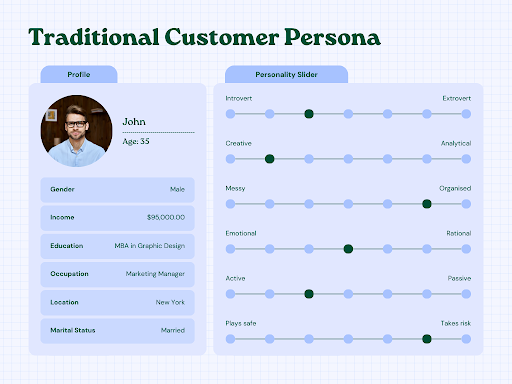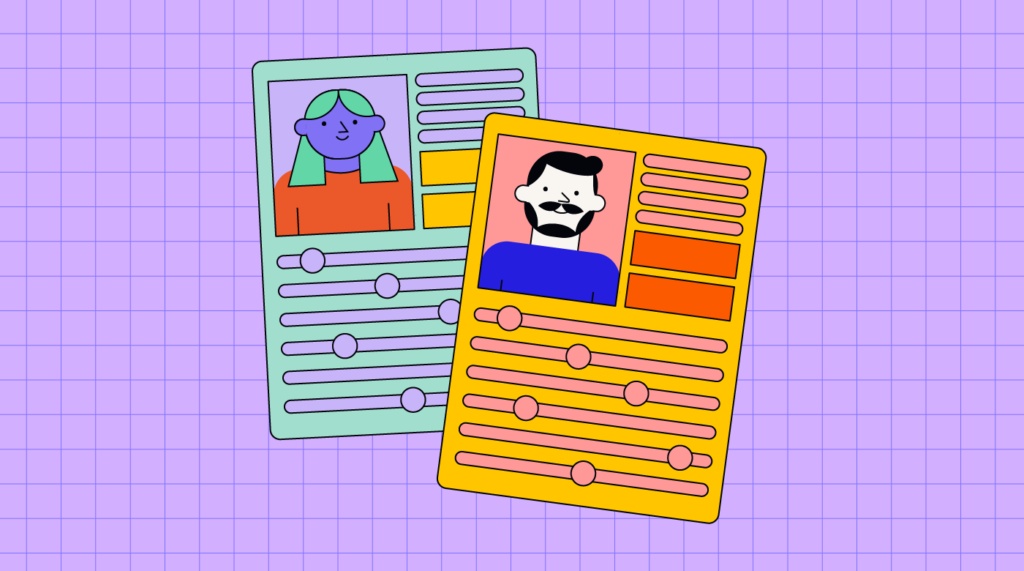Recently, I decided to become a meal prepper. Enough with cooking dinner from scratch every night, I thought! Better to cook a whole week’s worth of food in one fell swoop on Sundays. I read meal prep blogs, added new Ziploc bags and Tupperware to my Amazon cart, and generally paved the way for my new life as a meal prepper.
But then a realization hit me.
All of this meal prep activity still felt like a lot of work. What I really wanted was to find some way—any way—to get food on the table easily while reducing the time I spent on cooking and cleanup.
Once I shifted focus to my end goal, I found an affordable food delivery service, signed up, and that was that. Problem solved.
Traditional customer personas are a lot like my initial meal prep plan: obsessed with a product rather than an outcome. And that’s an issue, because it can lead to wasted product and marketing energy—plus worse outcomes for customers.
Now, this doesn’t mean we should scrap personas entirely! Far from it. Our mission today is to make your personas more robust, more accurate, and, most importantly, more reflective of your ideal customers’ motivations. Let’s start by looking at what’s wrong with traditional persona creation, and then move to a better, more real way of doing it.
Understanding The Shortcomings Of Traditional Persona Creation
We’ve all seen a customer persona like this one:
Meet ‘John,’ a 35-year-old marketing manager from New York. He's married, creative, active on the weekends, and holds an MBA.

Now, before I describe what’s wrong with this persona, let me say what’s right about it. Many product teams use personas to help visualize the user and build empathy toward them. Designing your product for a specific avatar with a name (”Oh, this feature is for John”) is more effective than designing for a generic customer base.
Including demographic information and personal details also gives marketing team members guidance on how to segment campaigns and target users.
But does this persona provide actionable information about your customers’ true motivations and needs?
Not really.
When personas are superficial and devoid of real motivations, they can lead us to make misguided marketing decisions and shape products that don’t truly serve our target customers. The consequence? Lower conversions and a worse user experience.
A Better Way To Think About Persona Creation
The Jobs-To-Be-Done (JTBD) framework is the customer persona game-changer you’ve been waiting for.
JTBD was created by Tony Ulwick in 1990. It’s a new way of thinking about persona creation that focuses less on demographic data and more on customer motivations.
Here’s the fundamental question posed by JTBD:
What’s the essential job that your product or service is being 'hired' to do by your customers?
For an example, look no further than Netflix and its one-time rival, Blockbuster Video. While Blockbuster was laser-focused on creating a better in-store DVD rental experience, Netflix focused on its customers’ core motivation:
Convenient entertainment at home.
That focus led Netflix toward the root of their customers’ problem: first, by mailing DVDs straight to customers’ homes, and later, by streaming movies and TV shows instantly over the Internet.
How JTBD Works
JTBD encourages you to focus on the problem your customer is trying to solve, rather than starting with your product and working backward to a target audience.
Staying focused on your customer’s problem helps you in a few ways:
- Flexibility: JTBD gives you space to evolve your product if there’s another approach that better addresses your customers’ core needs. Hallo, a language learning app, started with human language instructors and later added AI chatbots as another way to help its customers learn languages.
- Expansion: Understanding the end goal customers have for your product leads to natural opportunities for expansion. For example, Epic Gardening started as an informational website that helped people learn how to grow fresh, healthy food. To support customers toward that end goal, they expanded into physical products like raised beds, planters, and seeds.
- Mission: JTBD gives your brand a bigger purpose and sense of mission. As your mission seeps into your brand identity, it starts to resonate with the right customers and helps to grow your business.
How To Create Personas Using The JTBD Framework
The Jobs-To-Be-Done framework covers user research, persona design, and implementation.
1. Researching Your Customer’s JTBD
Don’t assume you know what your customer is buying your product to accomplish. You might guess correctly—but you also might be missing something. The only way to know for sure? User research.
Let’s say, for example, that you’re the founder of a fitness app. What’s motivating people to download your app? Is it the goal of losing weight, training for a competition, gaining general fitness, or improving mental clarity through yoga?
By conducting market research, holding user interviews, and gathering quantitative data, you can better understand what your primary customer segments are—and what job each segment is ‘hiring’ your app for.
To aid in your customer segmentation process, ask basic psychographic questions, like:
- What are your dreams?
- What are your biggest challenges?
- What are your interests and hobbies?
Then, gauge JTBD by asking questions about specific jobs. In the case of the fitness app, one of your questions might be: “How important is it that our app helps you with your weight loss goals?” You’ll also want to ask open-ended questions to pick up use cases you didn’t anticipate.
2. Designing Your Personas
Once you’ve got psychographic data and JTBD responses, synthesize this information into your persona descriptions.
Include demographic and personal data, but keep your primary focus on the jobs that each customer segment wants to get done. While JTBD focuses more on functional motivations than emotional ones, both can be useful.
Once you’ve painted a broad picture of your persona’s needs and motivations, you’ll want to add some life and personality. Here's where you layer in those humanizing details like a name, a photo, and personal details that align with your JTBD findings. This helps your team empathize with the various personas you design, leading to more user-focused design and marketing efforts.
For example, if your user persona is ‘Olivia,’ a 29-year-old woman struggling with procrastination, her JTBD could be "to improve focus, stop procrastinating, and get more done in less time." Understanding her underlying motivations in addition to her functional goals can support your marketing messaging.

3. Refining and Validating Your Personas
Keep in mind that your initial customer personas aren’t set in stone, nor have they been battle-tested against real customer data.
As your product gets more use, you’ll get a chance to compare your personas with reality. Embrace an iterative process and make sure to update your personas whenever the data calls for it. In fact, a study from Cintell found that high-performing companies are 7.4x more likely than others to have updated their personas in the last six months.
Your ultimate goal should be to make your personas as realistic and effective as possible. Through these ‘real’ personas, you'll be able to make more effective marketing decisions and cultivate a brand experience design that keeps customers coming back.
Putting Your New, ‘Real’ Personas To Work
So, you’ve created a new persona using the JTBD framework—and it’s more true to your customers’ needs than ever before. Fantastic! But how do you make sure these customer personas don’t just turn into fancy templates gathering digital dust?
Your personas should serve as your team’s North Star. Make them a central part of your marketing, design process, brand photography, and product development, and use the Jobs-To-Be-Done as an anchor to make sure your efforts remain customer-centered.
But your JTBD-infused personas shouldn’t only be discussed within the marketing and product teams. Make sure your personas have a seat at the table during brainstorming sessions. Whether you're planning a new feature or contemplating a major product overhaul, your personas’ motivations, and jobs should guide your decision-making.
Your customer support can also benefit. Our JTBD example persona—29-year-old Olivia—is focused on solving the act of procrastination, but also on creating a feeling of accomplishment. A savvy communication strategy from customer support can leave customers with the feeling they’re looking for, regardless of any issues they may be having with your product.
It’s Time To Reimagine Your Customer Personas
If your customer personas rely only on personality traits, job titles, and marital status, you’re missing out on their full potential. By using the JTBD framework, you can create realistic personas that bring you closer to truly understanding what motivates your target users.
In the process, you’ll get critical information to help mold your product, pivot your business, and expand into new streams of revenue.
Ready to dive deeper into customer personas? Check out our guide to research for user personas, and don’t miss the chance to subscribe to our newsletter and get our latest tips on perfecting the customer experience.


